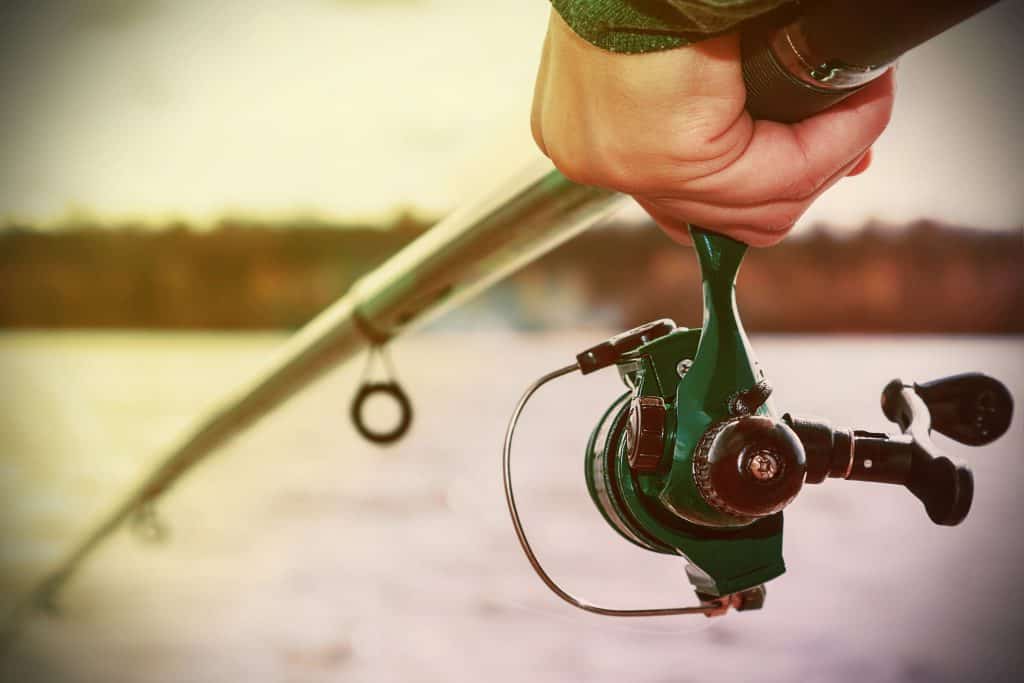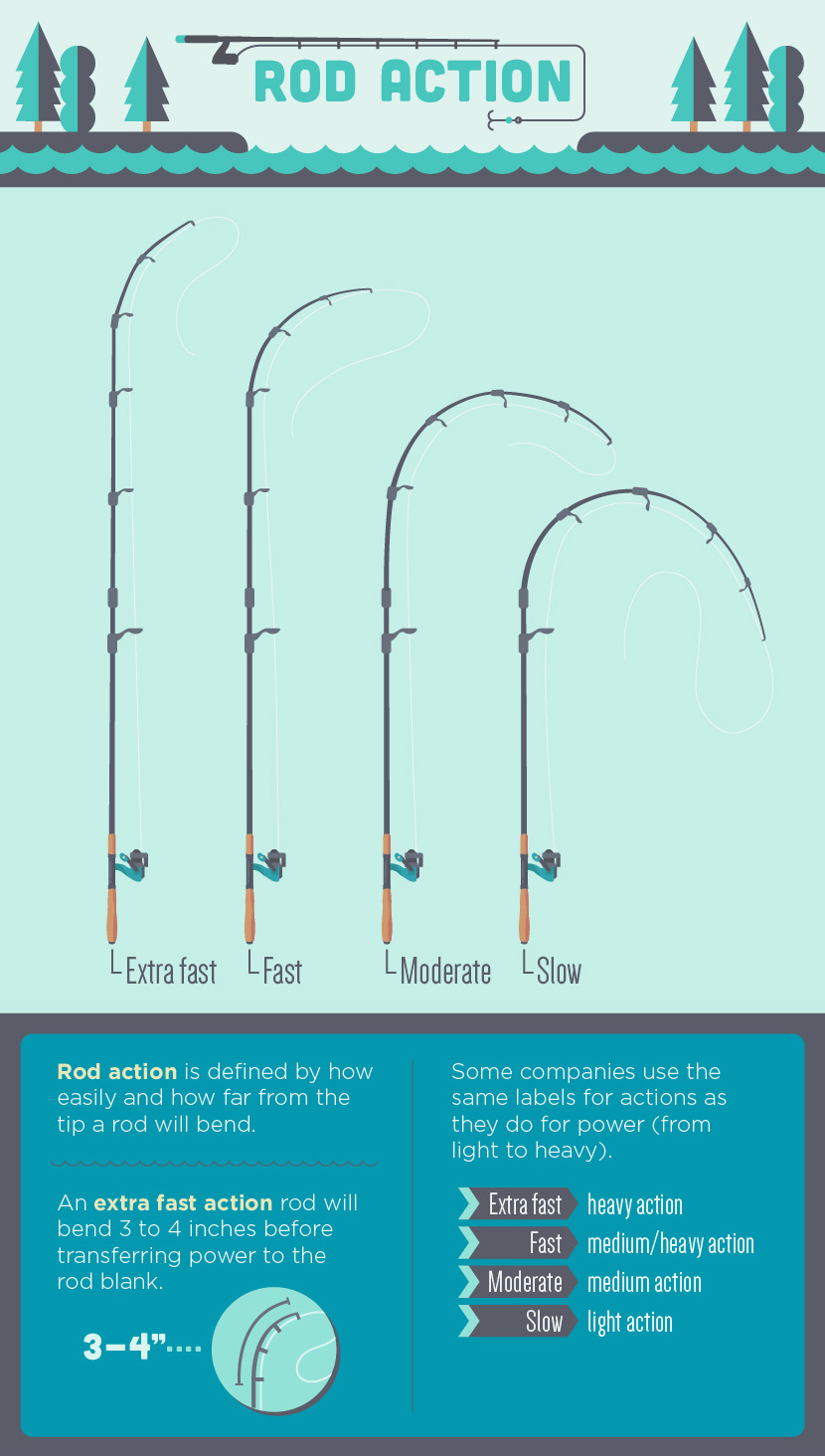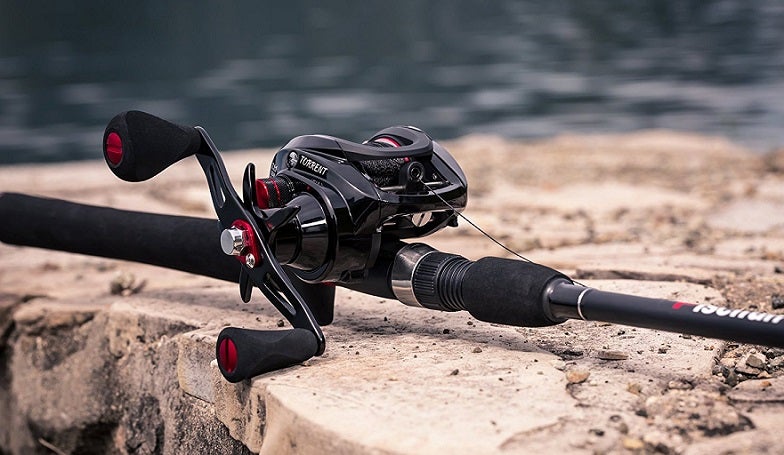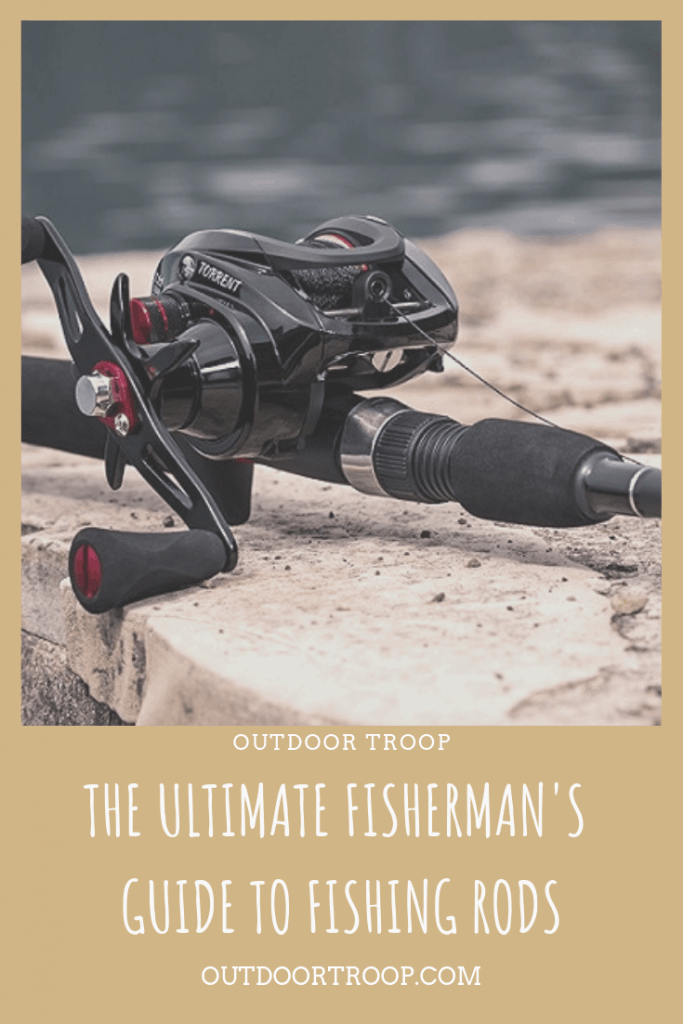
Fishing rods are one of the four main instruments used in catching fish. There is a lot to consider when looking to buy a rod. The considerations that one should think of are sometimes overthought, but not by the expert angler. Before committing to buy a rod, be sure to know everything you’ll need to know. Rods can get expensive, and it’s not good to waste money on a rod that won’t fit your needs or wants.
The type of fishing that you do will have a massive influence on the type of rod you’re looking to buy. If you’re going fly fishing please, for the love of God, don’t buy a casting rod. Not only will it not work, but you’ll probably end up hurting yourself or those around you.
Out of every method of fishing, I’m going to focus on these four types of fishing rods:
- Spin Rods
- Casting Rods
- Fly Rods
- Ice Rods
Fishing Rod Basics
There are a few things that are all the same for each rod that you will come in contact with, be it fly rod or spin rod. There are differences that make each rod behave differently in each situation, just like different breeds of dogs or cats.
Length
The length of rods can be anywhere from 2 – 14 feet. The usual lengths are usually from 6 feet to 8 feet. The benefit of having a 14-foot rod
There are a few different concerns with them, though. The maneuverability of the 14-foot rods is next to nothing. In a place like the beach, where there is nothing in your casting range, this isn’t a problem. But in a place like a riverbank or fishing a lake, there will most likely be trees and other plants in the way that will make fishing impossible.
There is a perfect length for every situation, but I’ve found that a 6 foot 6 inches rod is an all-around good rod length. It has a good casting distance but is also small enough that I can take it most places and not have too much of a problem casting.
A longer rod usually means more control over the fish, which is always a good thing. If you can control the fish, you can tire it out easier and get it to you faster.
Sensitivity
The sensitivity of a rod refers to where the rod starts to bend. There are two types of sensitivity that anglers look at the first is power, and the second is action.
Power – The power of the rod refers to how much weight it will take to bend the rod. If there is a force pulling the tip of the line 10 lbs down, and it barely moves, then the rod would be considered to have a heavy power level. If the rod drops significantly from that same weight, then the rod would be considered to be at a light power level. There is also a medium power level which is in between light and heavy.
Heavy rods are best used in ocean fishing where the fish will be large and require a lot of force to pull them out. The higher the power, the easier it will be to catch a fish (most of the time), but that offers not a whole lot of fun.
For smaller baitfish, such as panfish, lightweight rods are the better choice. These usually require a little more technique to use because the rods tend to be a little weaker. With small fish, though, this isn’t a problem. When fighting a bigger fish, however, the danger of breaking your rod comes into play that can turn into a reality very quickly.
This might seem like the heavier the rod, the more success you’ll have, and while that may sometimes be true, it’s a lot more fun to use lighter rods to fight an aggressive fish.
Action – The general location where the rod starts to bend as pressure is applied constitutes what action it will be labeled as. Slow action rods will start to bend clear down at the handle. The scale slowly works its way up until it reaches extra fast. The very top of the tip of the rod will start to bend. Moderate actions will start bending around the lower third, while fast action rods will start to bend just short of the top third of the rod.
The action of a rod can change how the rod works from the cast down to the hook set and the fight. Rods that are fast action are more suited to fling out heavier baits and lures. When the rod is pulled back after a bite to set the hook, the rod only gives a little before the stress can’t be absorbed by the angler. This means that there is the possibility that the hook could be ripped out of the mouth of the fish.
Fast action rods are usually a little better suited for plastics and other single hook lures that require more force to set and get lodged better.
A slow action rod will be better to cast out heavier baits and lures as the transferred power will be greater. When setting the hook after a strike from a fish, the rod will bend a lot and it will take a lot more stress for the fish to break free from the hook.

Species Specific Rods
Many companies, especially Okuma, have started to sell species-specific rods. Now it has become easier to know exactly what rid you should look into when buying a rod. For example, if you know that you want to catch a Steelhead Salmon, check out the Okuma Graphite Steelhead Rods.
Companies try to make everything as easy as possible when customers look at their products. Knowing the specific names for each type of rod
Materials
Graphite – Graphite rods are very sensitive. It’s what they’re known for, and its what they do best. Their extreme sensitivity is sometimes a downside, though. After you know what you’re feeling for, graphite rods can alert you too early and you’ll end up setting the hook too early, resulting in losing the fish.
Fiberglass – Fiberglass rods are heavier than graphite but not enough to hinder the fishermen. They are also significantly less sensitive than the graphite rods. They’re also cheaper than graphite, which makes them the best rods for beginners.
Composite Rods – The composite rods mix the best qualities of each graphite and fiberglass rods. They are strong, extremely sensitive, and even pretty cheap. They’re less than graphite, but a little more than fiberglass. Of course the cost is pretty variable, but for the most part, the price tags are somewhere in the middle.
Bamboo Rods – Bamboo Rods are generally shorter than other types of rods, which gives them an advantage in short spaces. The bamboo loads the line with a little tension making short and medium casts more accurate and easy to accomplish.
Companies
There are a few very good companies when it comes to quality rods. Okuma, Shakespear, Penn, and Shimano are really the only rods that I hear a lot about.
Shakespeare – If you’re looking for quality, Shakespeare is the brand. Their Ugly Stick Series is top class in the fishing industry, and has quite a hold on many fishermen’s hearts.
Okuma – A personal favorite, Okuma goes for quality at a good price. There is a lot of diversity in their products that try to target specific needs, and man, they hit them head-on.
Penn – The Penn brand is a solid choice that you really can’t go wrong when choosing. They don’t totally stand out in my opinion, but that doesn’t mean anything bad to their products. They’re a good choice.
Shimano – If you have a lot of extra money, you might want to consider buying a Shimano Rod. Otherwise, look somewhere else. Any rod worth buying from Shimano is over $150.
Spinning Rods
Spin rods are designed to be paired with spinning reels, the origin of its naming. The rods are designed to hold the reel on the underbelly of the rod with the ringlets, or line guides, also angled on the bottom side. This transfers most of the stress to the connection points to the ringlets and the rod. The rest of the stress is kept within the line.
Advantages
Spin rods are the best rod for beginner fishermen. They are easy to use, but can still be used skillfully to reap the best results.
Spin rods will always have the advantage, fishing with lighter lures. There isn’t much room to mess up when fishing a spin rod.
Disadvantages
Accuracy when casting a spin rod is somewhat iffy. Because of the action of the reel, with the spinning and such, the lure sometimes goes slightly astray. This can be bad for heavy vegetation and trying for super accurate casts.
One of the biggest disadvantages that spin rods have is the lack of advantages that the baitcasting rods have.
Baitcast Fishing Rods

Baitcast Fishing Rods are rods that have the reel slot on the top of the reel. The line guides are also positioned on the top of the rod. This has its benefits for the rod as well. The stress is transferred more to the rod and kept off of the ringlet connection points.
They are very hard to master, but once an angler does so, he will have much success.
Advantages
Casting rods have an advantage over other types of rods in the field of casting. Personally, I’ve been able to increase my max casting distance by 30 feet when I used a casting rod over a spin rod. The reason for this is the mechanics of the reel. You can choose the amount of friction on the line from the reel, which can be very beneficial.
The other advantage in casting the casting rod has over other rods is the accuracy difference. With a spinning rod, you usually shoot for a general area and drag the hook towards your exact destination. With a baitcasting rod, the accuracy can become almost ridiculous. Nine out of ten times I can land a lure or hook inside a 2-inch square at around 40 feet away from me.
These reason themselves are the reason that casting rods are the prime rod choice for heavily vegetated waters.
The rods are also more sensitive when compared to other types of rods. Because they are lighter, they have a higher level of control over the fish, which is always good. If you’re able to control the fish, then it will be tired out faster, which can get the fish to you quicker.
The sensitivity of casting rods is usually greater as well. This helps a lot with detecting the fish as it strikes or thinks about striking.
Disadvantages
While casting rods are amazing, they also harbor a lot of disadvantages as well. While it is more frequent with beginner fishermen, the baitcasting reels have a tendency to travel spit out line faster than the lure travels. This can back up the reel, creating a nasty birds nest tangle right in your reel. This can be rough, but it can also be costly. Depending on what kind of line you use, the line can be expensive to replace.
Another disadvantage of casting rods is the small fact that they are just more technical than other types of rods. To drop the line deeper, the only way is to loosen the reel and wait for it to drop down. With a spin rod, you just open the bail and it spins out.
Fly Rods
Fly fishing is a sport that has a lot of appeal for many people. There is something very satisfying about catching a fish on a lure that you yourself made and cast out.
The biggest visual difference of fly fishing than any other method is how the line is cast out. A spin rod or cast rod has one strong cast that sends out the line and hook in one direction.
A fly rod counts on the continuous movement of the angler as s/he moves his arm back and forth above their head until there is a satisfactory amount of line outside of the reel. The line and lure are then placed on the water with if done correctly, nothing more than a small plink. This is supposed to imitate an insect falling into the water.
The line is heavier and has a larger diameter than other methods, but this doesn’t concern the fish for some odd reason.
Fly fishing relies a lot on the fish’s aggressive instincts to strike at an insect that falls into the water. This happens quite frequently in the wild, especially around certain times of the day.
Advantages
The main advantage of fly rods is their uncanny ability to get very lightweight lures, or flies, at distances that seem like they shouldn’t be able to travel. This is because the line is weighted just enough to put the correct amount of weight to get the fly going.
The line is also a very good strike indicator for most every situation. Because the line floats and rests on the surface of the water, it will be very apparent when the line falls under because of a fish strike.
Disadvantages
There is a small safety concern with fly fishing. The method of casting has the fly, well, flying around the air. It can be pretty easy to mess up and get the hook stuck in either yourself, something important, or those around you.
Ice Rods

Ice rods are only used for one purpose: Ice fishing.
Because of this, there isn’t much demand for ice rods. Most are in-between 24″ and 28″, making them the smallest rods. They have the same power and action levels, but because they are so small, they are more responsive.
Ice fishing is done over a little hole in the ice on top of a lake. Most ice fishermen use a tent over their hole to keep warm out there in the wintertime.
Advantages
The advantages are more in the act of fishing than the actual equipment. Ice fishing is a type of vertical fishing. They look like really small spin rods because they have the same reel type. This allows the rods to drop line down without changing any settings on the reel.
Another advantage is that they allow you to be close to the hole instead of 6′ away and trying to feel for the fish.
Disadvantages
Because they are so specific, there isn’t really any other use for them outside of ice fishing. They can act as spin rods, but the longer 7′ rods outperform the tiny 2′ rods in any other situation besides ice fishing.
They don’t totally do much as a rod, so there aren’t very many advantages and disadvantages
Related Questions:
Can a spin reel be put on a bait rod? Technically, yes. But should you? No. They don’t totally work the best, but they do work. Serious fishers are better off either using a spin reel rod or a bait rod depending on the situation rather than attempting to combine the two.
Does spin or fly fishing catch more fish? It depends on the fisherman and the equipment that they use. If they’re using tackle for bass, they won’t have the best luck trying to catch trout. Both of them are different techniques, you are better off doing the one you enjoy more.

